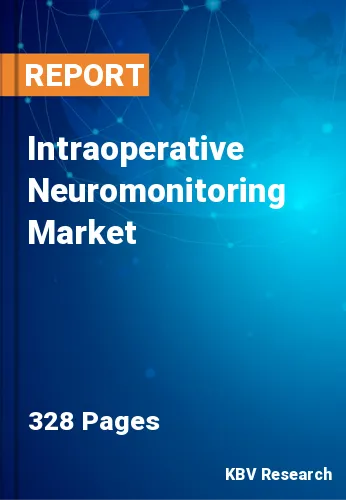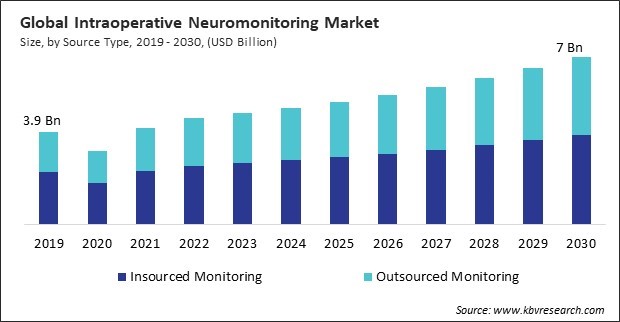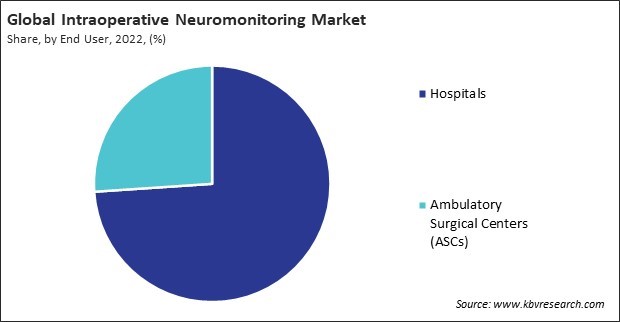
The Global Intraoperative Neuromonitoring Market size is expected to reach $7 billion by 2030, rising at a market growth of 6.0% CAGR during the forecast period.
Orthopedic surgeons frequently perform spinal surgeries, including spinal fusions, laminectomies, and discectomies. In these procedures, this neuromonitoring is vital for assessing the integrity of neural structures such as the spinal cord and nerve roots, ensuring their preservation during instrumentation and fusion processes. Consequently, the orthopedic surgery segment would acquire nearly 20% of the total market share by 2030. Orthopedic surgeries related to joint replacements, such as hip and knee replacements, may involve monitoring peripheral nerves to avoid injury during implantation. IONM provides valuable feedback to surgeons, helping prevent nerve damage and postoperative complications.

The overall growth in surgical procedures, including neurosurgery, orthopedics, and cardiovascular surgeries, significantly drives the demand for this neuromonitoring. As surgical volumes rise globally, so does the need for techniques that ensure the safety of critical neural structures. The adoption of minimally invasive surgical techniques is expanding across various medical specialties. In minimally invasive procedures, where direct visualization may be limited, this neuromonitoring provides real-time feedback to surgeons, contributing to the growth of IONM. Hence, the market is expanding significantly due to the increasing surgical procedures. Additionally, advancements in electrode technology have led to the development of high-resolution electrodes capable of capturing detailed neural signals. These electrodes provide clearer and more precise information about the functional integrity of neural structures during surgery. Surgeons and healthcare professionals can utilize these devices in various surgical settings, including ambulatory surgical centers and outpatient facilities. Advanced signal processing algorithms enhance the accuracy of data interpretation. Therefore, technological advancements in neuromonitoring technologies have been a pivotal factor in driving the growth of the market.
However, Regulatory bodies often impose stringent requirements for medical devices and procedures, including IONM systems. Manufacturers may find it difficult and expensive to meet these standards, which may delay the introduction of innovative technology. Smaller companies with innovative IONM solutions may face challenges navigating complex regulatory processes. This can create barriers to entry into the market for smaller enterprises, limiting competition and potentially hindering technological advancements. Hence, regulatory compliance and standardization are a significant challenge that hampers the growth of market.
Moreover, the availability of medical equipment, particularly IONM devices and accessories, was impacted by disruptions in the global supply chain. This led to delays in the procurement and maintenance of IONM systems. Hospitals and healthcare facilities faced the challenge of reallocating resources to manage the surge in COVID-19 cases. This resulted in a change in focus, emphasizing critical and emergency surgeries, which may affect the use of IONM in elective or non-urgent procedures. Thus, the COVID-19 pandemic had a moderate effect on the market.
 Drivers
Drivers  Restraints
Restraints Based on source type, the market is bifurcated into insourced monitoring and outsourced monitoring. The outsourced monitoring segment acquired a substantial revenue share in the market in 2022. Outsourced monitoring offers scalability and flexibility in adjusting monitoring services based on demand. Healthcare institutions can scale up or down their neuromonitoring services as needed without the constraints of maintaining a fixed in-house team. Outsourced monitoring services offer rapid deployment and on-demand availability. This can be particularly beneficial for healthcare facilities requiring immediate access to neuromonitoring services without delays associated with internal setup.
Based on end user, the market is segmented into hospitals and ambulatory surgical centers (ASCs). The ambulatory surgical centers (ASCs) segment covered a considerable revenue share in the market in 2022. ASCs have experienced a steady rise in the volume of surgical procedures performed on an outpatient basis. As the demand for ambulatory surgery increases, so does the need for this neuromonitoring to enhance patient safety and surgical precision. ASCs prioritize patient-centric care, and integrating this neuromonitoring aligns with this focus. ASCs can provide advanced care alternatives in a patient-friendly environment by improving patient safety and lowering the risk of neurological problems. As ASCs increasingly adopt this neuromonitoring, surgeons and medical staff become more familiar with the technology. This familiarity fosters a positive environment for integrating IONM into a broader range of surgical procedures at ASCs.

By products & services, the market is categorized into systems, accessories, and services. The accessories segment covered a considerable revenue share in the market in 2022. Specialized electrodes and sensors are crucial accessories in IONM. These components are directly applied to the patient to capture neural signals accurately. Advancements in electrode materials and designs contribute to improved signal quality and reduced interference, enhancing the overall reliability of IONM. Accessories that aid in precisely placing electrodes are essential for optimizing the monitoring process. These tools ensure accurate positioning, critical for obtaining reliable and meaningful neural data during surgery.
On the basis of application, the market is divided into spinal surgery, neurosurgery, orthopedic surgery, ENT surgery, vascular surgery, and others. The neurosurgery segment garnered a significant revenue share in the market in 2022. Neurosurgery involves highly intricate procedures within the brain and spinal cord. The complexity of these interventions necessitates precise monitoring of neural structures to avoid damage and ensure optimal outcomes. IONM provides real-time feedback to surgeons during neurosurgical procedures. Advances in neurosurgical techniques, including minimally invasive procedures and image-guided surgeries, are complemented by the integration of this neuromonitoring. The combined use of these technologies enhances the precision and safety of neurosurgical interventions.
By modality, the market is classified into motor evoked potentials (MEPs), somatosensory evoked potentials (SSEPs), electroencephalography (EEG), electromyography (EMG), brainstem auditory evoked potentials (BAEPs), and visual evoked potentials (VEPs). The electroencephalography (EEG) segment recorded a remarkable revenue share in the market in 2022. EEG is a valuable tool for monitoring brain function in real time. During surgeries, especially those involving the brain or procedures that may impact cerebral blood flow, EEG provides continuous feedback on the brain's electrical activity. EEG monitoring is extensively used in neurosurgical procedures, including brain tumor resections and epilepsy surgeries. Monitoring the EEG helps surgeons navigate critical brain regions and identify abnormal patterns, contributing to the success of these delicate procedures. EEG plays a crucial role in surgeries related to epilepsy, where precise localization of the epileptic focus is essential. Continuous EEG monitoring assists in identifying seizure activity and guides respective surgery or other interventions.
Free Valuable Insights: Global Intraoperative Neuromonitoring Market size to reach USD 7 Billion by 2030
Region-wise, the market is analysed across North America, Europe, Asia Pacific, and LAMEA. In 2022, the North America region led the market by generating the highest revenue share. North America boasts an advanced healthcare infrastructure with well-established medical facilities, research centers, and hospitals. The North American region witnesses a significant number of spinal surgeries, including procedures for degenerative spine conditions, herniated discs, and spinal fusions. The region experiences many orthopedic procedures, including joint replacements and complex orthopedic surgeries. The aging population in North America contributes to a higher demand for surgical interventions, particularly in neurosurgery and orthopedics.
| Report Attribute | Details |
|---|---|
| Market size value in 2022 | USD 4.4 Billion |
| Market size forecast in 2030 | USD 7 Billion |
| Base Year | 2022 |
| Historical Period | 2019 to 2021 |
| Forecast Period | 2023 to 2030 |
| Revenue Growth Rate | CAGR of 6% from 2023 to 2030 |
| Number of Pages | 328 |
| Number of Tables | 570 |
| Report coverage | Market Trends, Revenue Estimation and Forecast, Segmentation Analysis, Regional and Country Breakdown, Porter’s 5 Forces Analysis, Company Profiling, Companies Strategic Developments, SWOT Analysis, Winning Imperatives |
| Segments covered | Source Type, Products & Services, Modality, Application, End User, Region |
| Country scope |
|
| Companies Included | Nihon Kohden Corporation, inomed Medizintechnik GmbH, Medtronic PLC, SpecialtyCare, Inc. (Morgan Stanley), NeuroStyle Pte. Ltd., Computational Diagnostics, Inc., Accurate Neuromonitoring, LLC (Housatonic Partners), Intranerve Neuroscience Holdings, Llc, Natus Medical Incorporated (Archimed SAS) and Globus Medical, Inc. |
By Source Type
By End User
By Products & Services
By Application
By Modality
By Geography
The Market size is projected to reach USD $7 billion by 2030.
Technological advancements in neuromonitoring technologies are driving the Market in coming years, however, High-cost considerations of IONM systems restraints the growth of the Market.
Nihon Kohden Corporation, inomed Medizintechnik GmbH, Medtronic PLC, SpecialtyCare, Inc. (Morgan Stanley), NeuroStyle Pte. Ltd., Computational Diagnostics, Inc., Accurate Neuromonitoring, LLC (Housatonic Partners), Intranerve Neuroscience Holdings, Llc, Natus Medical Incorporated (Archimed SAS) and Globus Medical, Inc.
The expected CAGR of this Market is 6.0% from 2023 to 2030.
The Hospitals segment generated the highest revenue in the Market by End User in 2022; thereby, achieving a market value of $4.9 billion by 2030.
The North America region dominated the Global Intraoperative Neuromonitoring Market by Region in 2022, and would continue to be a dominant market till 2030; thereby, achieving a market value of $2.6 billion by 2030.
Our team of dedicated experts can provide you with attractive expansion opportunities for your business.
